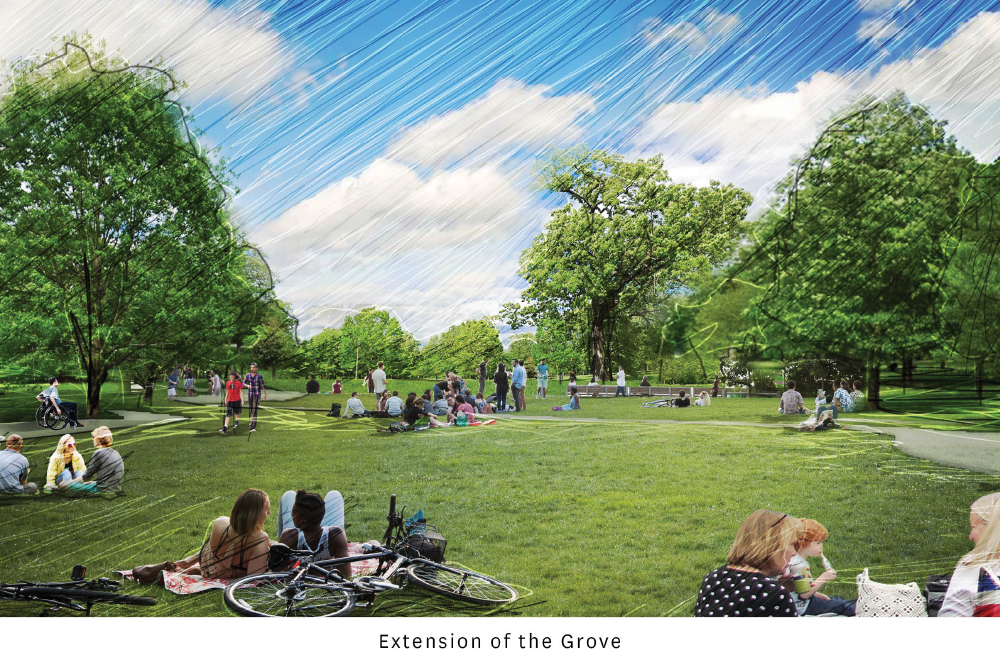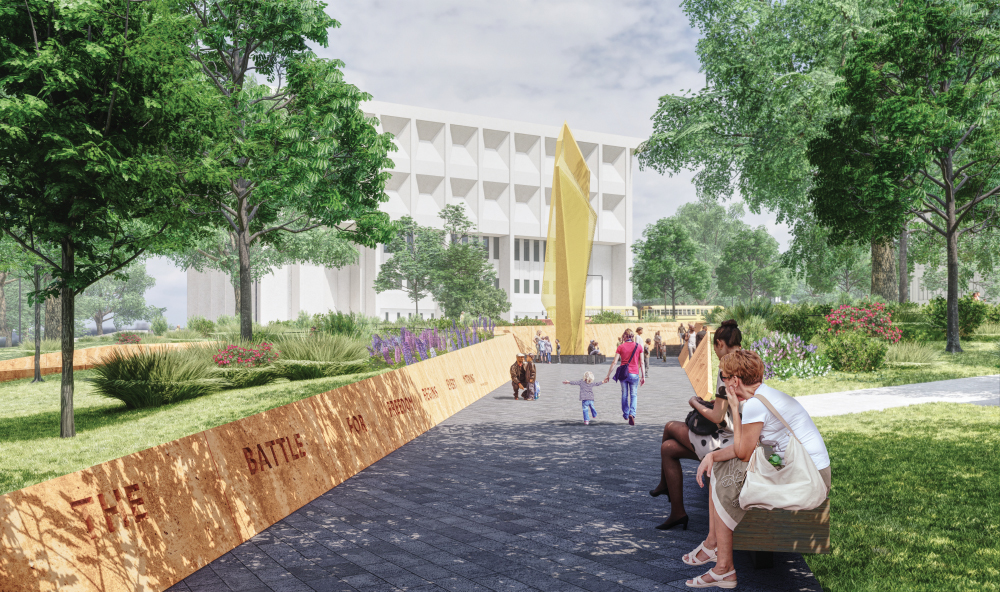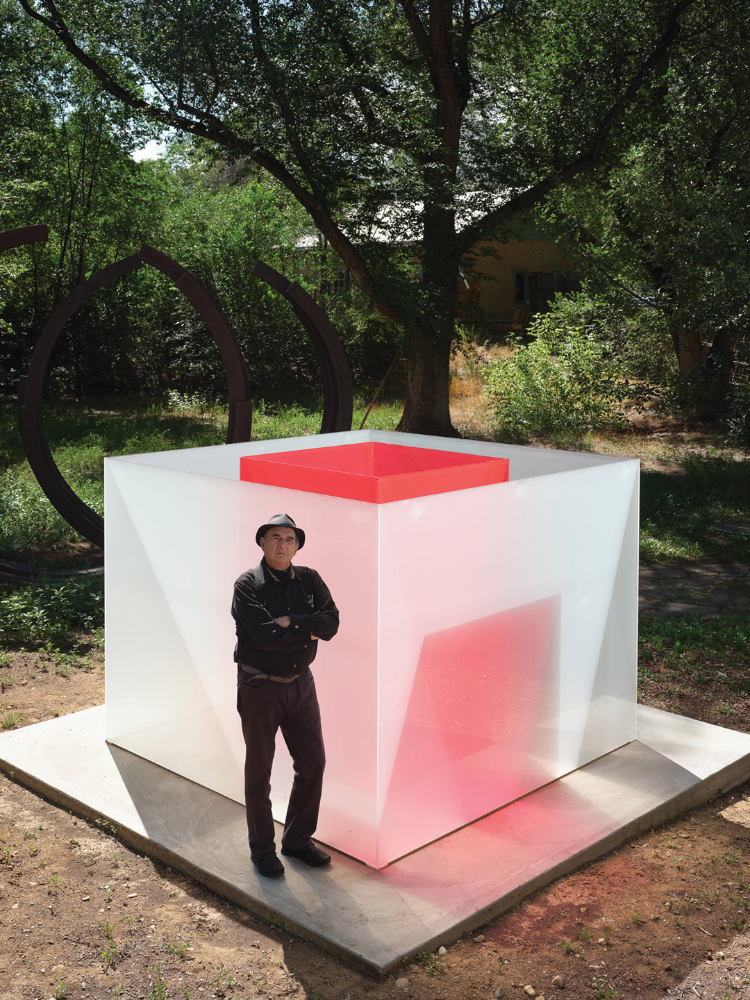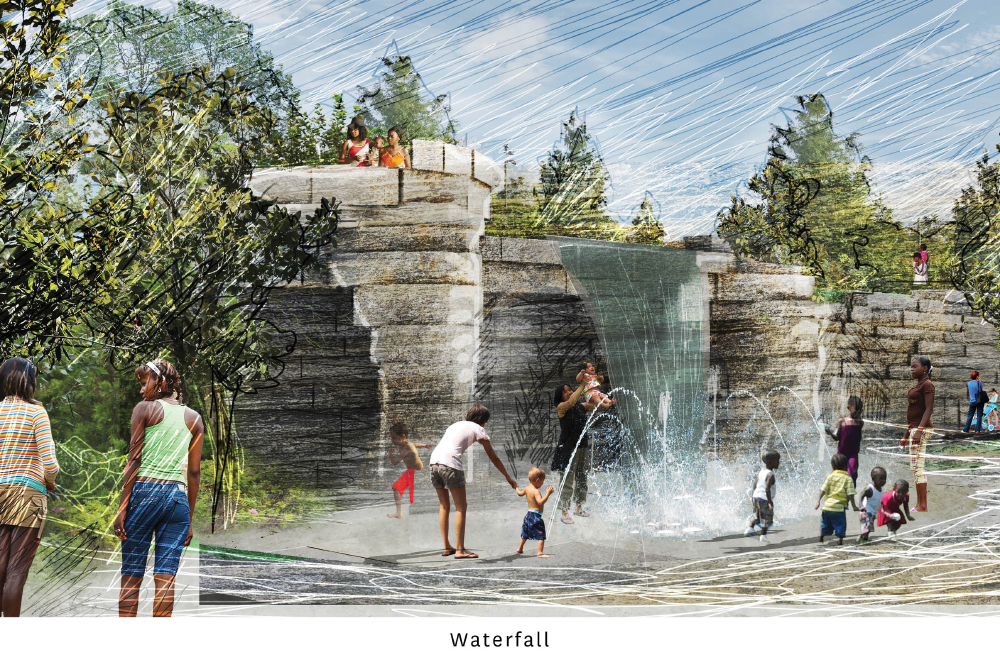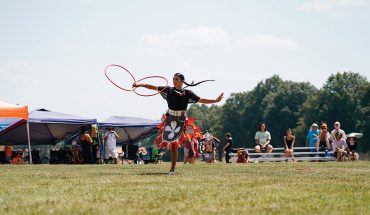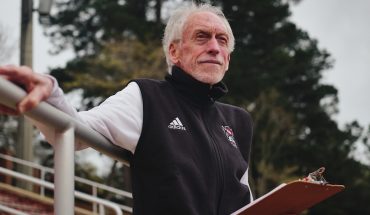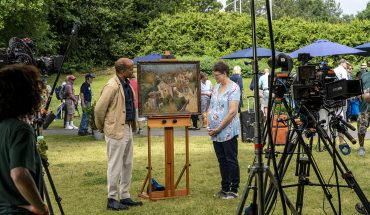Coming in 2022: monuments that invite reflection, art that could change your perspective, and a new place for all to connect and play.
Introduction by Ayn-Monique Klahre | Essays by Victoria Gallagher, Valerie Hillings, Nick Neptune, and Larry Wheeler
As we move into this year, there’s a shared sense of optimism and purpose. Big-time projects, some decades in the making, will be coming to fruition. These offer an opportunity to reframe the conversation in Raleigh: How are we using our space? How are we portraying our history and using it to contextualize our future? Can our choices make Raleigh not just a place that we enjoy, but a destination for folks from further afield?
In downtown Raleigh, the North Carolina Freedom Park will open this year, a free public space to contemplate our complicated history and look forward with a shared goal: freedom. At Dorothea Dix Park, the Gipson Play Plaza will get underway, creating a destination for Raleigh’s newest generation to recreate and build community. North Carolina State University has commissioned a unique outdoor art installation from a globally recognized artist that will invite folks onto its Centennial Campus. And the North Carolina Museum of Art is overhauling its floor plan as part of its reimagining of The People’s Collection, challenging visitors to see the pieces we love with fresh eyes.
If the last two years have been ones of upheaval, then 2022 promises to be one of momentum: growing with what we’ve learned, gathering together, and reaffirming Raleigh as the place where we love to live. Here, we’ve asked community leaders involved in the projects to share, in their own words, their enthusiasm for these projects.
North Carolina Freedom Park
Rooted in history — and reaching toward the future
by Victoria Gallagher
I am honored to be part of a dedicated group of citizens who have been working together to make the North Carolina Freedom Park a reality. When it opens next year, it will be the first park in the state to specifically acknowledge and celebrate the Black experience.
America’s past is complicated. Moving forward requires that we acknowledge our unsettling history while celebrating the accomplishments of so many people who pursued freedom in spite of slavery, overt racism, and systematic oppression.
It took 20 years of committed effort to build a consensus and find the resources to bring this long overdue yet necessary space into reality. This journey started in 2001, when the Paul Green Foundation, a North Carolina-based group for advancing the arts and human rights, conducted a series of town hall meetings across the state to explore ideas to honor the African American struggle for freedom. I was privileged to attend and facilitate these meetings, where community members, educators, activists, and leaders came together.
They were truly inspiring. Participants shared their experiences and engaged in difficult, albeit transformative, conversations about experiences of race and racism. We considered what we would like to say — together, in public — to honor the contributions of Black and African American citizens and to come to terms with our history of oppression.
The result of all this effort was support for a public park to be built in the Capital City that would be commemorative, inviting, and educational. In 2004, a multiracial, statewide group was created, with support from the Paul Green Foundation and the state Arts Council, to pursue planning and funding for this monumental project.
Over the next few years, members of the board, committed citizens, and community leaders engaged in site selection, artist selection, focus groups, planning meetings, and developing educational materials. Indeed, at one point, the suggestion was made that an apt memorial for this project would be a looping video of all of the meetings, discussions, and ideas that were considered
The resulting vision is of the creation of the NC Freedom Park, a national-caliber park that honors the African American experience and struggle for freedom in North Carolina. It will offer a different perspective into what public commemoration can look like. This park offers a place for school children, visitors, residents, and policymakers to learn about the contributions of African Americans, and to reflect upon the importance of full freedom for every citizen and the sanctity of justice and equality for all. There will be no statues of individuals in the park; instead, words will be our monuments.
Last year, the Freedom Park Board was awarded a $1.9 million grant from the Andrew W. Mellon Foundation as part of its Monuments Project Initiative, an effort to transform the nation’s commemorative landscape.
The NCFP Project was chosen for its innovative vision and design: the funds specifically support the construction of the park and the Beacon of Freedom, the pivotal piece of the park’s design, which was one of the last projects created by renowned architect Phil Freelon. It was his idea to illuminate the words of Black North Carolinians about freedom in order to reflect the deep roots of African American engagement in this state.
Freelon’s design envisions a beautiful green space adjacent to the General Assembly building and steps from the Executive Mansion. The roots of the trees in the park go deep down into history, while the light from the central beacon will shoot into the sky and the future.
The words inscribed on the walls of the park will be stark, sobering, and inspirational. Visitors will be struck by the beauty, resilience, and deep, indestructible humanity reflected in those words. A visit to Freedom Park will be an uplifting and transformational experience.
The Park’s design affirms that Black people have something important to say to the world about freedom. The people who can speak with the greatest power, conviction, and moral authority about freedom are the people who were denied it most completely: the people who were enslaved, and their descendants.
We were thrilled to break ground for the park last year. When it opens, we hope that if anyone, from any background, begins to take freedom for granted, or finds themselves discouraged or disillusioned because of hardships and oppression, that they will visit the Freedom Park. There, in the words of civil rights activist John Hervey Wheeler, they’ll remember that “the battle for freedom begins every morning.”
___
Dr. Victoria Gallagher is a professor at North Carolina State University. She’s on the board for the Freedom Park, and has consulted for Marbles Children’s Museum, Headstart of New Hanover County, and the North Carolina League of Women Voters.
Elevating NC State’s Design Reputation
A destination art installation at Centennial Campus
by Larry Wheeler
There’s a four-acre grassy plateau adjacent to the Hunt Library, the architectural gem of North Carolina State University’s Centennial Campus, and Fitts-Woolard Hall, its sleek new center for engineering innovation. The lawn connects these two modern landmarks to clusters of red brick classroom buildings and residences. Intended to function as a central gathering place for the new campus, it has thus far fallen short of its potential.
Susan Woodson, wife of Chancellor Randy Woodson and an energetic arts advocate, views this spare plaza as an opportunity to animate Centennial Campus with art that reflects its mission as a center for innovation and invention. She contends, passionately, that the genius at work inside these surrounding buildings should be expressed in works outside of the buildings that arouse curiosity and bring people together.
When Susan asked if I would help her identify artists who could help accomplish these goals, I, of course, agreed to help. I pointed out two caveats that must be reckoned with, however. One was to find artists of international caliber who would accept such a commission. The other was to manage the significant expense of doing it.
I described our ambition to Lauren Ryan, a highly regarded art advisor and partner with Anthony Meier Fine Arts in San Francisco — and a graduate of NC State’s Class of 2000. She jumped at the chance to help do something great for her alma mater. Within a few weeks, Lauren proposed that we consider the work of Larry Bell.
Bell is the preeminent artist of the Light and Space movement, a highly acclaimed and popular style of work centered around Op art, Minimalism, and geometric abstraction that emerged through the 1970s and 80s. His artistic explorations of the properties of glass are collected by art museums and sculpture parks throughout the world. (A series of his large red cubes was a centerpiece of the most recent Whitney Biennial in 2019.) Enjoying a renaissance of acclaim at age 82, we wondered: Would he be interested in taking on a big project for NC State?
In early 2020, Susan and a small group of local art patrons trekked to Austin, Texas, to see a new installation of Bell’s work and to meet the artist, who had agreed to come from his studio in Taos, New Mexico. In the parlance of New Age-y wisdom, the visit inspired a harmonic convergence of personalities and interests. He agreed to come to Raleigh to take a look, and he did in late February 2020, just before Covid closed down the world. The Woodsons’ hospitality only reinforced Bell’s commitment to create an ambitious, site-specific installation for that grassy plaza.
Red and Whites, the installation now being fabricated, consists of a four-part series of large cubes — and cubes within cubes — in different variations of the color red. They appear to explode and break into component parts over a 40-foot square plot. The cubes will be large enough to invite visitors within and around them, as the interactions between the overlapping panes of glass change the shapes and colors that come into view.
Art newsletter Design Dispatch, which featured this project in its November issue last year, claimed that this may “very well be a pinnacle in Bell’s illustrious career — no small statement for an artist who has masterfully harnessed and manipulated the hidden qualities of glass for six decades.” In an interview, Bell adds: “Although we tend to think of glass as a window, it’s a solid liquid that has three distinctive qualities: it reflects, absorbs, and transmits light — all at the same time.”
When installed later this year, the Larry Bell project promises to elevate the design reputation of NC State and take the powerful interactive role of public art to a new level of international importance.
___
Larry Wheeler, Director Emeritus of North Carolina Museum of Art, is a consultant to nonprofit organizations on vision and resource development. He is currently advising regional universities on major arts initiatives.
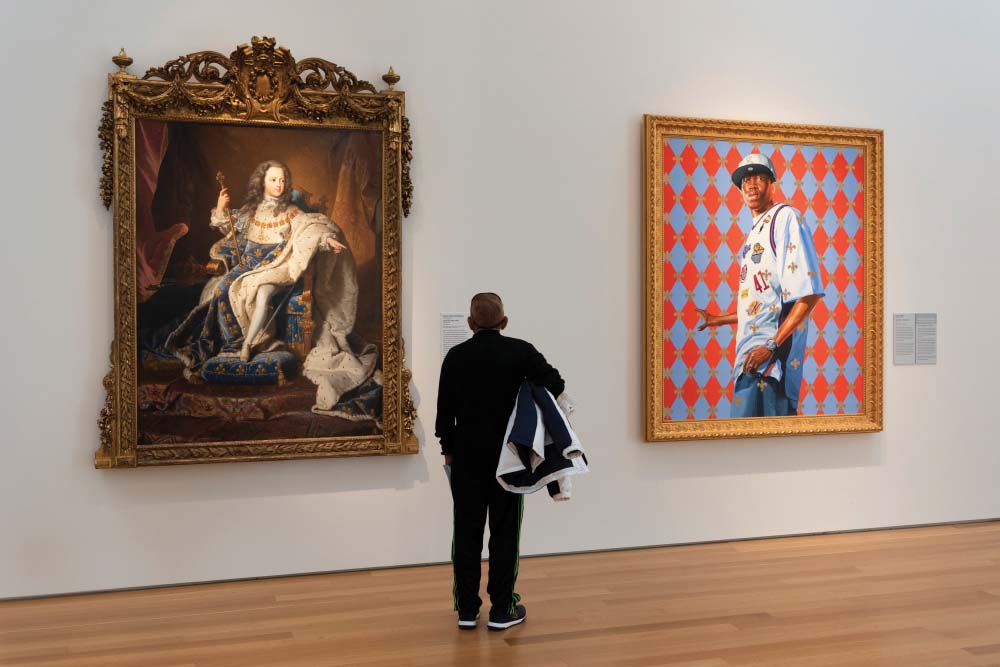
The People’s Collection, Reimagined
A gallery refresh at the NCMA for its 75th anniversary
by Valerie Hillings
This is an exciting year at the North Carolina Museum of Art: 2022 marks the 75th anniversary of the North Carolina Legislature setting aside funds to start the state’s art collection. The appropriation was unheard of at the time and drew national attention. To commemorate this milestone and further that commitment to accessibility and inclusivity through art, we will transform our galleries through an exciting reinstallation: The People’s Collection, reimagined.
This new presentation will offer a more dynamic experience of the arts through thematic and interpretive galleries that connect the collection across place and time. The approach will be much like our recent, popular Interchanges series, which placed vastly different artworks side-by-side to start conversations. Visitors will be able to explore more of these cross-cultural connections — for example, encountering Mickalene Thomas’ Three Graces: Les Trois Femmes Noires, 2011, hung alongside British and Flemish portraiture from the 1500s.
This is the first complete reorganization since the opening of West Building in 2010. We are excited to feature major loans from regional, national, and international museums and new, site-specific commissioned works, alongside visitor favorites presented in new ways. It’s been two years in the making, and we worked with input from 11 consultants across North Carolina and the United States.
The goal of these changes is to broaden representation and narratives in the galleries, to connect national and global cultures to our own communities here in North Carolina, and to transparently capture our shared histories. I’m especially proud of how we’ll present the new American gallery, with ancient American and Indigenous art alongside visitor favorites like pieces from artists Mary Cassatt, Aaron Douglas, and Winslow Homer. I can’t wait to unveil these changes in October.
While the collection galleries are under construction, including the closure of the West Building starting June 1, there will still be so much to see and do inside the Museum’s East Building and on our campus. One exhibition, Fault Lines: Art and the Environment, on view this spring, will highlight contemporary artists’ responses to current environmental concerns through an immersive, multimedia exhibition and outdoor sculpture installations. It includes works by artists John Akomfrah, Olafur Eliasson, Christine and Margaret Wertheim, Allison Janae Hamilton, and LaToya Ruby Frazier.
And this summer, we’ll celebrate the 25th anniversary of the Joseph M. Bryan, Jr., Theater in the Ann and Jim Goodnight Museum Park, so be sure to join us for musical and dance performances under the stars. There’s so much to come. I hope to see you soon at your North Carolina Museum of Art.
___
Dr. Valerie Hillings has led the NCMA since 2018, driving record-setting attendance that broke one million visitors in 2020. She previously managed global projects for the Solomon R. Guggenheim Museum and Foundation and received her B.A. in art history from Duke University and her M.A. and Ph.D. from New York University.
A Place for Play
Developing Dix as a destination for fun — and community
by Nick Nepture
Last month — or last year, depending on your perspective — Raleigh City Council voted unanimously to accept a $10 million donation in support of Dorothea Dix Park’s 18-acre Plaza and Play space from a Raleigh couple, Tom and Pat Gipson. Clearly in recognition of this generosity, the area will officially be called Gipson Play Plaza.
I’m thrilled by and grateful for this philanthropic largess, and frankly believe Raleigh Mayor Mary-Ann Baldwin’s assessment, in a recent interview in The News & Observer, that “this is a wonderful legacy, but it will be a legacy all our children can enjoy… this is a special moment for all of us and Dix Park.”
In its Master Plan, the transformation of Dix’s sprawling 308-acre landscape is guided by three core principles: to “open up and connect,” to build upon what is already there, and to offer something for everyone. Phase One of the plan includes physical improvements to approximately 120 acres of the park designed to facilitate more welcoming edges along Western Boulevard and Lake Wheeler Road. It includes the restoration of Rocky Branch Creek (water feature!), rehabilitating some of the existing buildings (historic preservation!), and the creation of a main gateway landscape featuring civic plazas and gathering spaces (community wellness!). This is the area that will include the Gipson Play Plaza.
Since last August, I have had the privilege of serving on the Dorothea Dix Park Community Committee, an advisory body featuring a cross-section of folks of all ages, backgrounds, and abilities that live in Raleigh and the greater region. Being engaged with the world-class designers and landscape architects leading Dix Park’s development, Michael Van Valkenburgh & Associates, has been a constant source of joy and wonder. From Zoom calls and site visits to public forums and post-work session drinks at Whiskey Kitchen, there’s been no doubt about the team’s enthusiasm and dedication to one of this nation’s most exciting park projects in a generation.
From one meeting to the next, seeing our ideas come to life — from grand entry plazas to iconic art features, cultural preserves to cookout zones, play spaces, and community gardens accessible to all ages and abilities — we’ve truly been witness to the design and development of an aspirational space. It’s open and inviting, an environment that uplifts and excites, a place for community, connection, and conversation; or, as the planning team likes to say — nearly an incantation — “a park for everyone.” The site, which sits on the eastern edge of the park, adjacent to Lake Wheeler Road, will offer an experience unlike any other in the Triangle, including climbing towers, a slide valley, waterplay mountain, a beautiful plaza and waterfall, and a picnic grove, all embedded within a garden setting.
Ultimately, Gipson Play Plaza at Dix Park is an investment in us and our growing city. It’s an investment in our shared spaces, what American sociologist and urban studies scholar Eric M. Klinenberg calls our “social infrastructure” in his critically acclaimed work, Palaces for the People. It’s a civic space in which we can see and meet each other and realize how we all want to keep a roof over our heads and food on the table; to realize and reaffirm that we each have a role to play in expanding opportunities for each other.
The ground-breaking for the initial phase of Gipson Play Plaza at Dix Park is set for July — and I sure hope to see you there.
___
Nick Neptune is the associate director of advocacy and education for WakeUP Wake County, a nonpartisan nonprofit that promotes smart and sustainable growth policies related to housing, transportation, and infrastructure; he’s also a member of the Dorothea Dix Park Community Committee.
This article originally appeared in the January 2022 issue of WALTER Magazine

